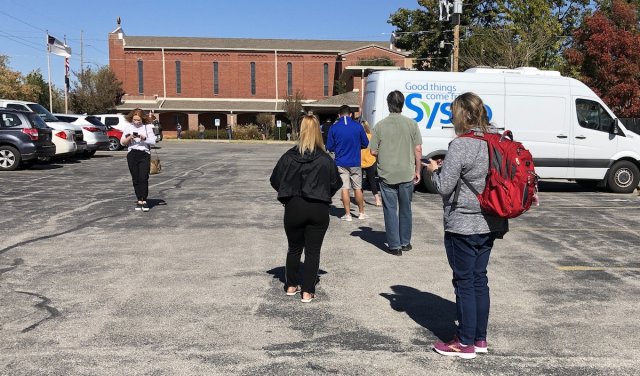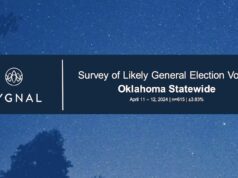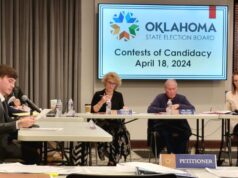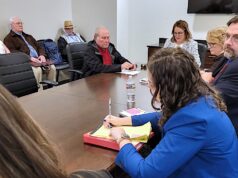

With states like Georgia undergoing a recount and several more battleground states having not yet certified their election results, things were typically quiet when it comes to how Oklahoma’s 2020 general election votes were counted.
While some states are still counting, Oklahoma certified its results a week after the election, and results were known in all of the state’s key races by 11 p.m. on Nov. 3.
This smoothness came in a year when an unprecedented number of Oklahomans voted by mail amid a pandemic. About 101,000 submitted absentee ballots in 2016. This year, that number swelled to 280,000.
All told, 1,560,699 million Oklahomans cast ballots for the Nov. 3 election, either by absentee, early voting or by going to the polls on Election Day. That spelled a state record for voter turnout, and it was an increase of about 100,000 over the 2016 presidential election.
Given that Oklahoma hasn’t been a swing state since Lyndon Johnson beat Barry Goldwater by 10 points in 1964, election experts are calling it a robust turnout.
“I was delighted to see the enthusiasm Oklahoma voters had in this election,” Oklahoma Election Board Secretary Paul Ziriax said. “There was a surge in voter registrations, and we set a record for absentee ballots and in-person voting.”
Ziriax said that, under the circumstances, the election went smoothly.
“When you consider it was a heavy turnout and a week after a major ice storm hit more than half of the state, I couldn’t be prouder of our county poll workers,” he said. “This was the toughest election we’ve ever had.”
Expired ID a problem for some
All told, 3,944 absentee ballots were rejected. Reasons for those rejections included incomplete affidavits (106), unreturned affidavits (527) and ballots being returned too late (631).
But the most common reasons election officials rejected a ballot were either because it lacked notarization or it did not included a form of identification when returned. There were 1,654 voters who had their ballots tossed for that reason.
And of the 3,944 total rejections, the majority came from the two largest counties. In Oklahoma County, 1,306 ballots were rejected, while Tulsa County had 616.
Early processing helped
Because of rules set by the Legislature, Oklahoma officials began processing absentee ballots before Election Day. In contrast, Pennsylvania’s state Legislature prohibited the processing of millions of mail in ballots in that state prior to Election Day.
“I don’t want to be critical of other states,” Ziriax said. “Some states don’t process ballots before Election Day. If that was the case here, we might still be counting 2020 votes. If we didn’t have that law in place, Oklahoma would be in a world of hurt. We wouldn’t be able to finish our count on Election Night.”
Early vote problematic for some
While Oklahoma was able to get its count completed quickly, not everything was perfect. There were long wait times reported in Oklahoma, Tulsa and other counties during the state’s early in-person voting period.
Jacob Carpenter spent more than four hours in line waiting to vote at the Oklahoma County Election Board, one of two early voting sites in the county.
He said he passed the time by talking to others in line. No matter their beliefs, each found themselves in the same snaking and seemingly endless line.
“Having fun people to talk with definitely made the time go by faster,” he said.
Carpenter said he wasn’t given a reason for the long wait.
“I could tell it was just the amount of people they could process in a given time frame that was holding it up,” he said. “There were probably 20 booths to vote once you got inside the building, and the line had to be at least a thousand people, if not more.”
Ziriax said the pandemic and need for social distancing did cause some delays with in-person voting.
“When you look at the social distancing requirements and not being able to pack voting booths together, it definitely slowed down the process,” he said.
Few reports of electioneering
The Oklahoma chapter of the National Lawyers Guild had about 50 people observing the election in Tulsa and Oklahoma counties, according to chapter organizer Ronni Laizure.
Electioneering is against the law in most states. Simply put, campaigns can’t campaign at polling places and any attempt to harass voters in line is also prohibited.
“We did see several reported examples of electioneering,” she said. “This included candidate materials beyond the prescribed distance to the ballots. Other than a few incidents like that, we didn’t see a lot.”
Laizure said the observers attend polling places to make sure rules are followed by everyone.
“The value of the legal observer program is that it shows voters and poll workers how to identify electioneering or voter intimidation,” she said. “It’s great to have someone around who values democracy and free and fair elections, who is trained to deal with situations that may arise.”
Room for improvement
While Oklahoma’s elections usually pass without much trouble, there could be room for improvement.
For starters, Carpenter said more polling places during early voting would be a benefit. He said the 2020 general election only strengthened his belief that the system is not as good as it could be.
“The fact that there are only two early voting locations across only two and a half days in a metro area of nearly 1.5 million people is absurd,” he said. “Voting needs to be something that can be done quickly and safely by all, without having to exert a massive amount of energy.”
Laizure said long waits can discourage participation.
“I definitely think Oklahoma could do more to expand access to the ballots to more segments of our community,” she said. “Longer periods for mail in voting and more access to the polls over a longer period of time (would help).”




















